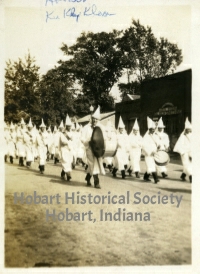
Members of the Ku Klux Klan parading down Third Street in Hobart in the early 1920s. Image courtesy of the Hobart Historical Society.
I've just begun reading Citizen Klansmen: The Ku Klux Klan in Indiana, 1921-1928 by Leonard J. Moore. I have to admit I've always avoided reading about the Klan because it's such a depressing topic, so I ought to remedy my ignorance, and this book's Introduction promises a more nuanced view than I've been accustomed to hold:
While the Klans of the Reconstruction and civil rights eras were driven primarily by the single issue of white supremacy in the South, the Klan of the 1920s espoused ... a more complex creed of racism, nativism, Americanism; the defense of traditional moral and family values; and support for Prohibition. … To some degree, the Klan of the twenties may have appeared even more threatening precisely because its list of enemies was so long, including, in addition to blacks, Catholics, Jews, immigrants, political radicals, feminists, intellectuals, gamblers, bootleggers, thrill-seeking teenagers, motion picture producers, and many others. … This book … asserts that the traditional interpretation contains basic flaws and ultimately does not divorce strongly enough the Klan movement of the twenties from the infamous traditions of the southern vigilante Klans.
Sounds interesting, but the text looks pretty intense. A lot of statistics, and statistics aren't my strong suit.
Saturday morning at the Hobart Historical Museum, I was able to find — along with that photo of the Klan parade above — portraits of two of the Hobart doctors who ran that 1907 Notice of fees, so I've added them to that post.


No comments:
Post a Comment